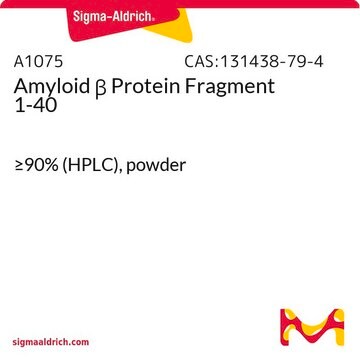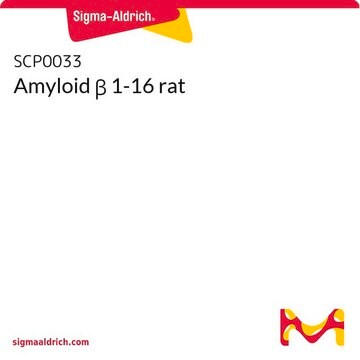All Photos(1)
About This Item
Empirical Formula (Hill Notation):
C190H291N51O57S1
Molecular Weight:
4233.72
UNSPSC Code:
12352200
NACRES:
NA.32
Recommended Products
Assay
≥95% (HPLC)
form
lyophilized
composition
Peptide Content, ≥75%
storage condition
protect from light
storage temp.
−20°C
Amino Acid Sequence
Asp-Ala-Glu-Phe-Gly-His-Asp-Ser-Gly-Phe-Glu-Val-Arg-His-Gln-Lys-Leu-Val-Phe-Phe-Ala-Glu-Asp-Val-Gly-Ser-Asn-Lys-Gly-Ala-Ile-Ile-Gly-Leu-Met-Val-Gly-Gly-Val-Val
Application
Amyloid β (Aβ) refers to peptides derived from Amyloid precursor protein that vary in length from 36-43 amino acids. Aβ(s) peptides, their peptide fragments and mutated fragments are used to study a wide range of metabolic and regulatory functions including activation of kinases, regulation of cholesterol transport, function as a transcription factor, and regulators of inflammation. Aβ(s) peptides and their peptide fragments are also used to study oxidative stress, metal binding and mechanisms of protein cross-linking in the context of diseases such as Alzheimer′s disease and neurodegeneration.
Storage Class Code
11 - Combustible Solids
WGK
WGK 1
Flash Point(F)
Not applicable
Flash Point(C)
Not applicable
Certificates of Analysis (COA)
Search for Certificates of Analysis (COA) by entering the products Lot/Batch Number. Lot and Batch Numbers can be found on a product’s label following the words ‘Lot’ or ‘Batch’.
Already Own This Product?
Find documentation for the products that you have recently purchased in the Document Library.
Customers Also Viewed
Xuehong Yu et al.
Neurobiology of learning and memory, 123, 168-178 (2015-06-14)
Single-session anodal transcranial direct current stimulation (tDCS) can improve the learning-memory function of patients with Alzheimer's disease (AD). After-effects of tDCS can be more significant if the stimulation is repeated regularly in a period. Here the behavioral and the histologic
Lian Hong et al.
The journal of physical chemistry. B, 114(34), 11261-11271 (2010-08-10)
There is no consensus on the coordinating ligands for Cu(2+) by Abeta. However, the differences in peptide sequence between human and rat have been hypothesized to alter metal ion binding in a manner that alters Cu(2+)-induced aggregation of Abeta. Herein
Maryam Bagheri et al.
Neurobiology of learning and memory, 95(3), 270-276 (2010-12-15)
Alzheimer's disease (AD) is a debilitating neurodegenerative disorder characterized by increased β-amyloid (Aβ) deposition and neuronal dysfunction leading to impaired learning and recall. Ageing, heredity, and induced oxidative stress are among proposed risk factors. The increased frequency of the disease
Yan Wang et al.
Neuropharmacology, 62(2), 871-881 (2011-10-01)
Alzheimer's disease (AD) is a progressive neurodegenerative disease characterized by the accumulation of β-sheet-rich amyloid oligomers or fibrils which are associated with cellular toxicity in the brain. Inhibition of Aβ aggregation could be a viable therapeutic strategy for slowing and/or
Aynun N Begum et al.
Journal of Alzheimer's disease : JAD, 15(4), 625-640 (2008-12-20)
The rat amyloid-beta (Abeta) intracerebroventricular infusion can model aspects of Alzheimer's disease (AD) and has predicted efficacy of therapies such as ibuprofen and curcumin in transgenic mouse models. High density lipoprotein (HDL), a normal plasma carrier of Abeta, is used
Our team of scientists has experience in all areas of research including Life Science, Material Science, Chemical Synthesis, Chromatography, Analytical and many others.
Contact Technical Service





